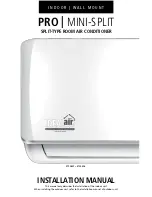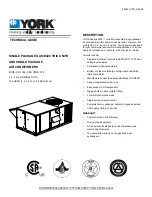
Air Conditioning Centre / Martin Industries Ltd
©
2004 - 2009
5
Model KFR-32GW/X1c rev. 409
2
How to bend the copper pipes correctly by hand
DO NOT use a 15mm pipe bender as the pipes are ½” and this will crush them as they will spread
and be flattened! Do not use any internal bending springs as you will damage the pipe internally by
chafing the copper.
Follow the instructions below.
The copper pipes take a little patience and care to bend suitable curves without crushing or
kinking. There are 2 pipes, one is ¼” and the other is ½”. The quarter inch is fairly soft and will bend
easily to a gentle curve, be careful not to kink though as it is very soft! Be gentle and patient and
you will have perfect bends!
The ½” pipe requires a bit more patience; you will be able to achieve a radius of 5” or perhaps even
4” if you are careful. First of all, cut round the foam insulation (do not cut into the copper) and slide
apart the insulation at the point you want to bend or curve the pipe, so that you can see the copper
pipe itself. Then, working from the centre position of your required curve, placing your thumbs
together, press them up into the copper pipe and gently draw down with your fingertips on either
side (rather like snapping a stick), be careful to ‘feel’ the pipe bending and stop as it starts to
depress. Move along an inch, left or right and make another tiny impression with your thumbs and
pull down slightly with your fingertips. Continue in this way, making perhaps 30 or so tiny indents,
until you have a perfect curve, Observe the pipe and check it is not depressed more than 1mm in
any place. Then slide back the foam insulation until it meets, then tape the joint with some good
waterproof tape. Make all required curves in the same way.
3a
Installation of the Outdoor Unit
z
The outdoor unit must be fitted HORIZONTALLY so that the 4 metal ‘feet’ are flat on the mounting
surface in a horizontal position.
z
The outdoor unit must be firmly fixed to
avoid falling over in strong winds (see
notes above).
z
The large fan with grille over must be facing
outwards from any wall; this is the front of
the unit.
z
Install on a cement base as in the drawing
or use our wall brackets (available
separately).
z
If it is installed near coastal areas or high
above the ground where strong winds are
likely, the unit should be installed close to a
wall to ensure the normal operation of the
fan and a wind blocking construction (like
an open planked shelter, ‘picket fence style’)
should be made.
z
If it is an overhanging installation (using wall mounting brackets), the structure of the mounting
wall should be made of a solid brick, concrete, or materials with equivalent strength, and of
sufficient support capacity. Otherwise, measures such as reinforcement, support or vibration
damping should be adopted.
z
Always check the fastness and security of all wall
mounted installation bolts every few months to
ensure safety.






























